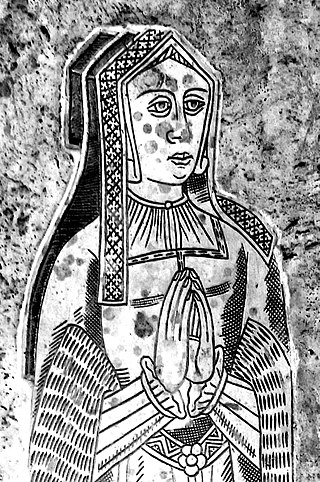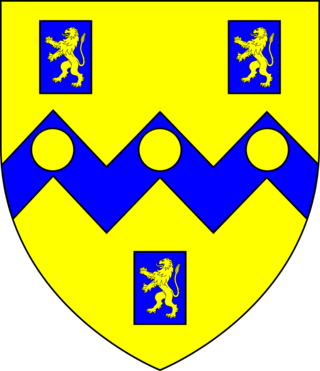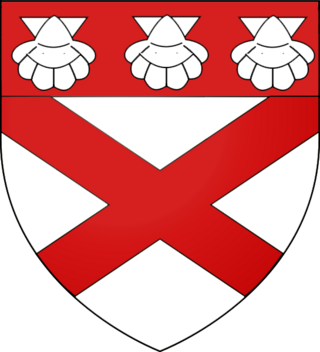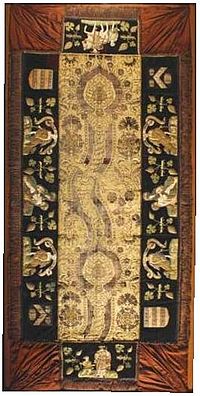Arthur Plantagenet, 1st Viscount Lisle, KG was an illegitimate son of the English king Edward IV, half-brother-in-law of Henry VII, and an uncle of Henry VIII, at whose court he was a prominent figure and by whom he was appointed Lord Deputy of Calais (1533–40). The survival of a large collection of his correspondence in the Lisle Letters makes his life one of the best documented of his era.

Sir Thomas Arundell of Wardour Castle in Wiltshire was a Cornish administrator and alleged conspirator.

William Sandys, 1st Baron Sandys, KG, of The Vyne in the parish of Sherborne St John, Hampshire, was an English diplomat and was a favourite of King Henry VIII, whom he served as Lord Chamberlain. In the 1520s he built a palatial Tudor-style mansion at "The Vyne", which survives in a reduced and classicised form as a possession of the National Trust.
Robert Radcliffe, 10th Baron Fitzwalter, 1st Earl of Sussex, KG, KB, PC, also spelt Radclyffe, Ratcliffe, Ratcliff, etc., was a prominent courtier and soldier during the reigns of Henry VII and Henry VIII who served as Chamberlain of the Exchequer and Lord Great Chamberlain.
Anne Basset was an English lady-in-waiting of the Tudor period, reputed to have been the mistress of King Henry VIII.

Sir John Basset, of Tehidy in Cornwall and of Umberleigh in Devon was Sheriff of Cornwall in 1497, 1517 and 1522 and Sheriff of Devon in 1524. Although himself an important figure in the West Country gentry, he is chiefly remembered for his connection with the life of his second wife and widow Honor Grenville, who moved into the highest society when she remarried to Arthur Plantagenet, 1st Viscount Lisle KG, an illegitimate son of King Edward IV, and an important figure at the court of King Henry VIII, his nephew.
Katharine Basset was an English gentlewoman who served at the court of King Henry VIII, namely in the household of Queen Anne of Cleves, and was briefly jailed for speaking against him. Three of her letters to her mother Honor Grenville survive in the Lisle Papers.

Honor Grenville, Viscountess Lisle was a Cornish lady whose domestic life from 1533 to 1540 during the reign of King Henry VIII is exceptionally well-recorded, due to the survival of the Lisle Papers in the National Archives, the state archives of the UK.
The Lisle Papers are the correspondence received in Calais between 1533 and 1540 by Arthur Plantagenet, 1st Viscount Lisle (c.1480-1542), Lord Deputy of Calais, an illegitimate son of King Edward IV and an uncle of King Henry VIII, and by his wife, Honor Plantagenet, Viscountess Lisle, from several servants, courtiers, royal officials, friends, children and other relatives. They are an important source of information on domestic life in the Tudor age and of life at the court of Henry VIII.

Sir Hugh Pollard lord of the manor of King's Nympton in Devon, was Sheriff of Devon in 1535/6 and in 1545 was appointed Recorder of Barnstaple in Devon.
Elizabeth Grey, 6th Baroness Lisle was an English noblewoman during the reigns of Henry VII and VIII.

Sir William Courtenay"The Great", of Powderham in Devon, was a leading member of the Devon gentry and a courtier of King Henry VIII having been from September 1512 one of the king's Esquires of the Body. He served as Sheriff of Devon three times: from February to November 1522, 1525/26, and 1533/34. He was elected Knight of the Shire for Devon in 1529.

Sir Richard Pollard, was Member of Parliament for Taunton in 1536, and for Devon in 1540 and 1542. He played a major role in assisting Thomas Cromwell in administering the Dissolution of the monasteries.

George Rolle of Stevenstone in the parish of St Giles in the Wood near Great Torrington in Devon, was the founder of the wealthy, influential and widespread Rolle family of Devon, which according to the Return of Owners of Land, 1873 in the person of Hon. Mark Rolle, the adoptive heir of John Rolle, 1st Baron Rolle, had become by that year the largest landowner in Devon with about 55,000 acres. He was a Dorset-born London lawyer who in 1507 became Keeper of the Records of the Court of Common Pleas and was elected as a Member of Parliament for Barnstaple in 1542 and 1545. He became the steward of Dunkeswell Abbey in Devon, and following the Dissolution of the Monasteries he purchased much ex-monastic land in Devon. Not only was he the founder of his own great Devonshire landowning dynasty but he was also an ancestor of others almost as great, including the Acland baronets of Killerton, the Wrey Baronets of Tawstock and the Trefusis family of Trefusis in Cornwall now of Heanton Satchville, Huish, later Baron Clinton, heirs both of Rolle of Heanton Satchville, Petrockstowe and of Rolle of Stevenstone.

George Tailboys was the eldest son of Elizabeth Blount and Gilbert Tailboys, 1st Baron Tailboys of Kyme. Through his mother he was the half brother of Henry FitzRoy, 1st Duke of Richmond and Somerset, who was the only illegitimate offspring acknowledged by Henry VIII, King of England.

Sir Thomas Grenville II, K.B.,, lord of the manors of Stowe in Kilkhampton, Cornwall and Bideford, Devon, Sheriff of Cornwall in 1481 and 1486. During the Wars of the Roses, he was a Lancastrian supporter who had taken part in the conspiracy against Richard III, organised by the Duke of Buckingham. On the accession of King Henry VII (1485–1509) to the throne, Sir Thomas was appointed one of the Esquires of the Body to Henry VII. On 14 November 1501 upon the marriage of Prince Arthur to Katherine of Aragon, he was created a Knight of the Bath. He served on the Commission of the Peace for Devon from 1510 to his death in circa 1513.

Edward Grey, 1st Viscount Lisle was an English nobleman who was created Viscount Lisle in 1483, in recognition of his wife's descent.

Richard Coffin (1456–1523) of Alwington and Heanton Punchardon in North Devon, was a Sheriff of Devon.

John Basset (1518–1541) was a young English gentleman from Devon, a member of the old Basset family, and heir to a substantial inheritance. His short life is well documented in the Lisle Papers. He studied law at Lincoln's Inn and at the age of 20, at the start of a promising career, entered the household of Thomas Cromwell, Lord Privy Seal, but died suddenly aged only 23, albeit having married and produced a son and heir, born posthumously. His stepfather and father-in-law was Arthur Plantagenet, 1st Viscount Lisle (d.1542), Lord Deputy of Calais 1533–1540, a bastard son of King Edward IV and thus uncle of King Henry VIII, whose arrest with that of his mother in 1540 at Calais for heresy and treason, was a major, potentially catastrophic, event in his life. He died a year after the arrests, from an unknown illness, but his siblings all went on to have successful careers, especially his younger brother James, mostly as royal courtiers, apparently unaffected by the crisis.
William Popley ., was an English mercer and land owner, whose association with Thomas Cromwell, enabled him to take advantage of the opportunities presented by the dissolution of the monasteries to secure extensive landed estates.














